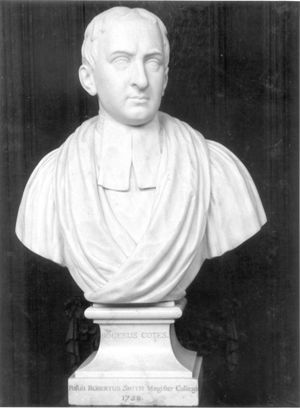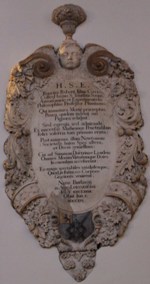Roger Cotes

1682-1716. Mathematician who worked with Newton; the first Plumian Professor of Astronomy; FRS.
Cotes attended Leicester School and St Paul's School before Trinity, where he graduated in 1706. He began his educational career with a focus on astronomy. He became a Fellow of Trinity in 1707, and at 26 he became the first Plumian Professor of Astronomy and Experimental Philosophy. On his appointment as Professor he opened a subscription list in an effort to provide an observatory for Trinity, which Bentley had built on the Great Gate. The observatory was still unfinished when Cotes died, and was demolished in 1797.
In correspondence with Newton, Cotes designed a heliostat telescope with a mirror revolving by clockwork. He recomputed the solar and planetary tables of Cassini and Flamsteed, and he intended to create tables of the moon's motion, based on Newtonian principles. In 1707 he and William Whiston formed a school of physical sciences at Trinity.
From 1709 to 1713, Cotes became heavily involved with the second edition of Newton's Principia, a book that explained Newton's theory of universal gravitation. The first edition of Principia had only a few copies printed and was in need of revision to include Newton's works and principles of lunar and planetary theory. Newton at first had a casual approach to the revision, since he had all but given up scientific work. However, through the vigorous passion displayed by Cotes, Newton's scientific hunger was once again reignited. The two spent nearly three and half years collaborating on the work, in which they fully deduce, from Newton's laws of motion, the theory of the moon, the equinoxes, and the orbits of comets. Only 750 copies of the second edition were printed. However, a pirate copy from Amsterdam met all other demand. As reward to Cotes, he was given a share of the profits and twelve copies of his own. Cotes's original contribution to the work was a preface which supported the scientific superiority of Newton's principles over the then popular vortex theory of gravity advocated by Descartes. Cotes concluded that the Newton's law of gravitation was confirmed by observation of celestial phenomenon that were inconsistent with the vortex phenomena that Cartesian critics alleged.
Cotes's major original work was in mathematics, especially in the fields of integral calculus, logarithms, and numerical analysis. He published only one paper in his lifetime, entitled Logometrica, in which he successfully constructs the logarithmic spiral. After his death, many of Cotes's mathematical papers were hastily edited by his cousin Robert Smith, later Master of Trinity, and published in a book, Harmonia mensurarum. Cotes's additional works were later published in Simpson's The Doctrine and Application of Fluxions. Although Cotes's style was somewhat obscure, his systematic approach to integration and mathematical theory was highly regarded by his peers. Cotes discovered an important theorem on the nth roots of unity, foresaw the method of least squares, and discovered a method for integrating rational fractions with binomial denominators. He was also praised for his efforts in numerical methods, especially in interpolation methods and his table construction techniques. He was regarded as one of the few British mathematicians capable of following the work of Newton.
Cotes died in 1716 at only 33 years old, and was buried in old All Saints’, Cambridge. His memorial was paid for by his successor in the Plumian chair, his cousin Robert Smith. Newton remarked, "If he had lived we would have known something."
| Memorial inscription | Translation |
|
H.S.E. Rogerus Roberti filius COTES CollegI [sic] hujus S Trinitatis socius |
Here is buried Roger Cotes son of Robert Cotes, Fellow of Trinity College and Plumian Professor of Astronomy and Experimental Philosophy. Snatched away by an early death, he left few tokens of his genius; but these few are of no common kind, exciting admiration for their having been first unearthed from the very heart of learning by his successful intelligence. After the great Newton he was the second hope of the College, and its twin ornament. Every possible quality of character and virtuous behaviour crowned his scientific fame; and these qualities were the more splendid and attractive because they were lodged in a handsome body. He was born in Burbage in Leicestershire on 10th July 1682 and died on 5th June 1716. |
|
PREVIOUS SCULPTURE |
|
NEXT SCULPTURE John Davies |
| Sculpture Gallery |
Brass Gallery | Statue Gallery | Interments & Tombstones Gallery | War Memorial Gallery |

